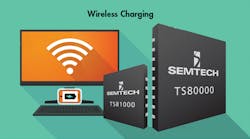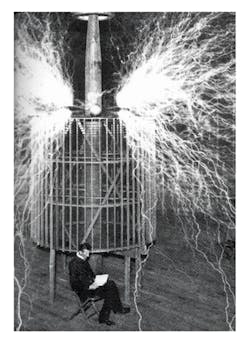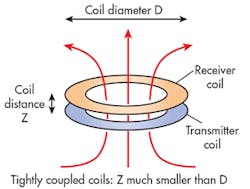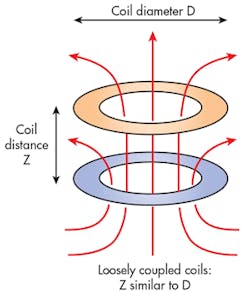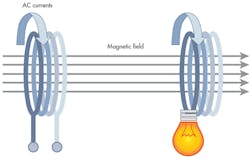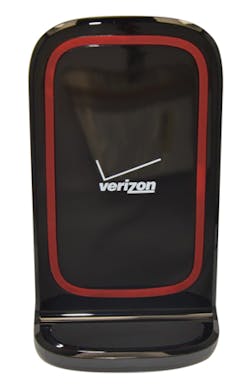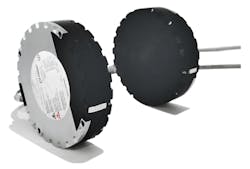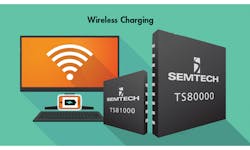This file type includes high-resolution graphics and schematics when applicable.
The race to create a universal wireless-charging technology is on. New and exciting wireless-charging technological advances and products continue to emerge, with some companies committed to one technology and others working with several. But a lack of interoperability between technologies still remains a major issue, due to the non-existence of a unified wireless-power standard.
The idea of wireless-power transfer has been around for years. In the early 1900s, Nikola Tesla was very involved in creating a way to supply power without wires across the world, but never achieved total success. He came close, though, with his revolutionary invention called the Tesla coil. This system, which transmitted electricity without wires, changed the way electricity was used (Fig. 1).
Transmission of power without interconnected wires via short distances can be accomplished through different technologies or methods—electromagnetic induction, magnetic resonance, capacitive coupling, magneto-dynamic coupling, etc. The first two in that group are probably the most commonly used in today’s market.
Electromagnetic Induction (Inductive Coupling)
This near-field method transmits power wirelessly using a magnetic field created between coils of wire. When current circulates through a transmitter coil, it generates a magnetic field that induces a voltage in the receiver coil.
The better the coils are coupled, the better the power transmission. Couple factor k indicates the grade of coupling. The value k depends on several elements, such as the shape of the coils, the angle between them, and the distance between inductors.
Depending on the distance between the transmitter coil and the receiver coil, the system can operate as a loosely or tightly coupled system.
In a tightly coupled system, the transmitter and receiver coils are the same diameter size. They’re aligned with each other with a minimal Z distance between them. The distance Z is much less than the coil diameter. This system tends to produce less heat and higher efficiency (Fig. 2).
A loosely coupled system, on the other hand, trades off a larger distance between coils for lower power-transfer efficiency and higher electromagnetic emissions (Fig. 3).
Electromagnetic induction has several advantages, such as the simplicity of its circuit scheme and its cost-effectiveness. Major disadvantages include the limited charging distance and the necessity for precise alignment between the transmitter and receivers.
Magnetic Resonance (Resonant Inductive Coupling)
This near-field method transmits power wirelessly over a space utilizing a resonance phenomenon based on the same principle as electromagnetic induction. The transmitter and receiver coils oscillate (or resonate) at the same frequency, which is determined by the material and shape of the coil (Fig. 4).
The main advantage of magnetic resonance is its ability to transmit electrical energy over a relatively long distance without precise alignment between transmitters. However, this technology comes at a higher production cost due to complex circuit control.
Trending Products
Most of the products populating the market right now rely on magnetic-induction and magnetic-resonance wireless-charging technologies. These include:
• Qi: Created by the Wireless Power Consortium (WPC), Qi charges or powers an array of devices from smartphones to cordless kitchen appliances. It combines induction and resonance technologies. Figure 5 shows one of the many products that support the Qi standard.
• PowerbyProxi: These members of the WPC deliver resonant wireless solutions in a number of battery-powered applications, but design constraints limit their effectiveness. They offer several product solutions for the industrial field. For example, the Proxi-Point wireless connector provides power to sensors in hard-to-reach locations and recharges batteries (Fig. 6).
WiPower: Qualcomm is a member of both the WPC and Airfuel Alliance. Its WiPower technology is based on the principles of magnetic resonance. WiPower recently announced that it can deliver wireless charging to devices with metal exteriors.
• WiTricity: This magnetic-resonator-based technology is designed for distances anywhere from a centimeter to several meters. It was created for original equipment manufacturers (OEMs) to embed directly in their products and systems (Fig. 7). WiTricity is an active member of Airfuel Alliance.
• Powermat: This technology, based on electromagnetic induction, consists of a pad that charges electronic devices. It was certified by the Power Matters Alliance (PMA). Devices with built-in wireless charging can power up instantly on charging spots. If the device isn’t enabled, a plug-in Powermat Ring is used to wirelessly enable it (Fig. 8).
One theme becomes rather apparent when looking at these trending products: Magnetic resonance and electromagnetic induction rule the roost from a technology standpoint. The choice of one technology over the other depends on the application.
Wireless charging is a new and still-growing market. As more technologies and products arrive, consumers can expect the market to be replete with interoperable products.
Major Players
Two key organizations in this space that work with both magnetic resonance and electromagnetic induction are the Wireless Power Consortium (WPC) and Airfuel Alliance. The WPC, founded in 2008, is the creator of the Qi standard. Members of the WPC are working together toward a global standardization of wireless-charging technology. More than 200 companies offer more than 800 products combined that support the Qi standard. Members of the board of management include LG, Qualcomm, Samsung, Texas Instruments, Toshiba, and Verizon.
Airfuel Alliance is a global ecosystem that’s the result of a recent merger (June 2015) between the Power Matters Alliance (PMA) and Alliance for Wireless Power (A4WP). Some of the companies that form its board of directors are AT&T, Intel, On Semiconductor, Powermat, Samsung, and WiTricity.
It’s worth mentioning that the Power Matters Alliance (PMA) is a global, not-for-profit, industry organization that’s working to create a paradigm for wireless-power technology. Its founding member is Powermat. Similarly, the Alliance for Wireless Power (A4WP) is an independently operated, not-for-profit organization dedicated to building a global wireless-charging ecosystem based on Rezence technology.
Unfortunately, this battle for standards doesn’t create any functionality, interoperability, or flexibility between the WPC and Airfuel Alliance. Some big names in the manufacturing industry, such as Microsoft, Qualcomm, and Samsung, have hedged their bets by becoming members of both the WPC and Airfuel Alliance. Therefore, their products support both wireless-charging standards.
Semtech Corp. is another company with dual membership. Last October, Semtech launched a new wireless-charging platform capable of supporting all major standards (Qi, PMA, and A4WP Rezence). The TS80K platform, which includes the TS800000 transmitter and TS81000 receiver, supports multiple system configurations for wearable, mobile, and embedded-systems applications (Fig. 9).
The TS80K offers flexibility because the platform supports all major wireless-charging standards in multimode (for both transmitter and receiver applications). In addition, it can quickly be adapted to support evolving wireless-charging standards. The TS80K platform handles a wide range of power solutions, from 100-mW wearable solutions to 100-W solutions for industrial tools, medical equipment, and “connected” furniture applications.
The TS80K’s multimode transmitter solutions work with power levels ranging from 100 mW to more than 40 W. As a result, it enables embedded charging capability in furniture, vehicles, and public venues that can support all major wireless standards based on a single, easy-to-use, cost effective platform.
Lack of agreement on standards between the Wireless Power Consortium and Airfuel Alliance has suppliers taking a slow approach toward incorporating these technologies in their products. Once a clear winner is declared in this wireless-standard battle, the market should quickly turn into a multi-billion-dollar business for universal wireless chargers. In the end, customers will be able to pick and choose from an abundance of options.
